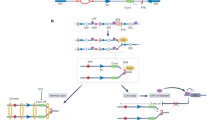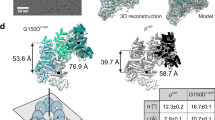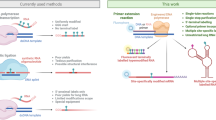Abstract
A detailed protocol for the synthesis of a fluorescent pyrimidine ribonucleoside analogue and its enzymatic incorporation into an RNA strand by transcription reactions is described. Furan-modified ribonucleoside triphosphate is synthesized in two steps with an overall yield of 33%. Incorporation of the triphosphate into an RNA oligomer occurs with nearly 225-fold amplification over the amount of the DNA template. Bacterial rRNA decoding site (known as the A-site) derived from this fluorescently modified ssRNA positively signals a binding event upon interaction with aminoglycoside antibiotics, its cognate ligands. The total time for the synthesis of ribonucleoside triphosphate is ∼6 days, and that for the incorporation of the nucleoside triphosphate and purification of the fluorescently labeled RNA ∼40 h.
This is a preview of subscription content, access via your institution
Access options
Subscribe to this journal
Receive 12 print issues and online access
$259.00 per year
only $21.58 per issue
Buy this article
- Purchase on SpringerLink
- Instant access to full article PDF
Prices may be subject to local taxes which are calculated during checkout




Similar content being viewed by others

References
Wojczewski, C., Stolze, K. & Engels, J.W. Fluorescent oligonucleotides—versatile tools as probes and primers for DNA and RNA analysis. Synlett 1667–1678 (1999).
Hawkins, M.E. Fluorescent pteridine nucleoside analogs: a window on DNA interactions. Cell Biochem. Biophys. 34, 257–281 (2001).
Murphy, C.J. Photophysical probes of DNA sequence-directed structure and dynamics. Adv. Photochem. 26, 145–217 (2001).
Rist, M.J. & Marino, J.P. Fluorescent nucleotide base analogs as probes of nucleic acid structure, dynamics and interactions. Curr. Org. Chem. 6, 775–793 (2002).
Okamoto, A., Saito, Y. & Saito, I. Design of base-discriminating fluorescent nucleosides. J. Photochem. Photobiol. C 6, 108–122 (2005).
Ranasinghe, R.T. & Brown, T. Fluorescence based strategies for genetic analysis. Chem. Commun. 5487–5502 (2005).
Silverman, A.P. & Kool, E.T. Detecting RNA and DNA with templated chemical reactions. Chem. Rev. 106, 3775–3789 (2006).
Coleman, R.S. & Madaras, M.L. Synthesis of a novel coumarin C-riboside as a photophysical probe of oligonucleotide dynamics. J. Org. Chem. 63, 5700–5703 (1998).
Strässler, C., Davis, N.E. & Kool, E.T. Novel nucleoside analogues with fluorophores replacing the DNA base. Helv. Chim. Acta 82, 2160–2171 (1999).
Seela, F., Zulauf, M., Sauer, M. & Deimel, M. 7-substituted 7-deaza-2′-deoxyadenosines and 8-aza-7-deaza-2′-deoxyadenosines: fluorescence of DNA-base analogues induced by the 7-alkynyl side chain. Helv. Chim. Acta 83, 910–927 (2000).
Coleman, R.S. & Mortensen, M.A. Stereocontrolled synthesis of anthracene beta-C-ribosides: fluorescent probes for photophysical studies of DNA. Tetrahedron Lett. 44, 1215–1219 (2003).
Dash, C., Rausch, J.W. & Le Grice, S.F. Using pyrrolo-deoxycytosine to probe RNA/DNA hybrids containing the human immunodeficiency virus type-1 3′ polypurine tract. Nucleic Acids Res. 32, 1539–1547 (2004).
Jiao, G.S., Kim, T.G., Topp, M.R. & Burgess, K. A blue-to-red energy-transfer thymidine analogue that functions in DNA. Org. Lett. 6, 1701–1704 (2004).
Okamoto, A., Kanatani, K. & Saito, I. Pyrene-labeled base-discriminating fluorescent DNA probes for homogeneous SNP typing. J. Am. Chem. Soc. 126, 4820–4827 (2004).
Gaballah, S.T., Vaught, J.D., Eaton, B.E. & Netzel, T.L. Charge-transfer excited state dynamics in DNA hairpins substituted with an ethylenylpyrenyl-dU electron source and halo-dU traps. J. Phys. Chem. B 109, 5927–5934 (2005).
Okamoto, A., Tainaka, K. & Saito, I. A dielectric-sensitive fluorescent DNA probe for monitoring polarities on the interior of a DNA-binding protein. Bioconjug. Chem. 16, 1105–1111 (2005).
Sandin, P. et al. Fluorescent properties of DNA base analogue tC upon incorporation into DNA—negligible influence of neighbouring bases on fluorescence quantum yield. Nucleic Acids Res. 33, 5019–5025 (2005).
Asseline, U. Development and applications of fluorescent oligonucleotides. Curr. Org. Chem. 10, 491–518 (2006).
Cho, Y. & Kool, E.T. Enzymatic synthesis of fluorescent oligomers assembled on a DNA backbone. Chem. Bio. Chem. 7, 669–672 (2006).
Kim, S.J. & Kool, E.T. Sensing metal ions with DNA building blocks: fluorescent pyridobenzimidazole nucleosides. J. Am. Chem. Soc. 128, 6164–6171 (2006).
Ward, D.C., Reich, E. & Stryer, L. Fluorescence studies of nucleotides and polynucleotides. I. Formycin, 2-aminopurine riboside, 2,6-diaminopurine riboside, and their derivatives. J. Biol. Chem. 244, 1228–1237 (1969).
Jean, J.M. & Hall, K.B. 2-Aminopurine fluorescence quenching and lifetimes: role of base stacking. Proc. Natl. Acad. Sci. USA 98, 37–41 (2001).
Kawai, M., Lee, M.J., Evans, K.O. & Nordlund, T.M. Temperature and base sequence dependence of 2-aminopurine fluorescence bands in single- and double-stranded oligodeoxynucleotides. J. Fluoresc. 11, 23–32 (2001).
Rachofsky, E.L., Osman, R. & Ross, J.B. Probing structure and dynamics of DNA with 2-aminopurine: effects of local environment on fluorescence. Biochemistry 40, 946–956 (2001).
Menger, M., Tuschl, T., Eckstein, F. & Porschke, D. Mg(2+)-dependent conformational changes in the hammerhead ribozyme. Biochemistry 35, 14710–14716 (1996).
Kirk, S.R., Luedtke, N.W. & Tor, Y. 2-Aminopurine as a real-time probe of enzymatic cleavage and inhibition of hammerhead ribozymes. Bioorg. Med. Chem. 9, 2295–2301 (2001).
Rist, M. & Marino, J. Association of an RNA kissing complex analyzed using 2-aminopurine fluorescence. Nucleic Acids Res. 29, 2401–2408 (2001).
Lacourciere, K.A., Stivers, J.T. & Marino, J.P. Mechanism of neomycin and Rev peptide binding to the Rev responsive element of HIV-1 as determined by fluorescence and NMR spectroscopy. Biochemistry 39, 5630–5641 (2000).
DeJong, E.S., Chang, C.E., Gilson, M.K. & Marino, J.P. Proflavine acts as a Rev inhibitor by targeting the high-affinity Rev binding site of the Rev responsive element of HIV-1. Biochemistry 42, 8035–8046 (2003).
Kaul, M., Barbieri, C.M. & Pilch, D.S. Fluorescence-based approach for detecting and characterizing antibiotic-induced conformational changes in ribosomal RNA: comparing aminoglycoside binding to prokaryotic and eukaryotic ribosomal RNA sequences. J. Am. Chem. Soc. 126, 3447–3453 (2004).
Shandrick, S. et al. Monitoring molecular recognition of the ribosomal decoding site. Angew. Chem. Int. Ed. Engl. 43, 3177–3182 (2004).
Tam, V.K., Kwong, D. & Tor, Y. Fluorescent HIV-1 dimerization initiation site: design, properties, and use for ligand discovery. J. Am. Chem. Soc. 129, 3257–3266 (2007).
Wu, P., Nordlund, T.M., Gildea, B. & McLaughlin, L.W. Base stacking and unstacking as determined from a DNA decamer containing a fluorescent base. Biochemistry 29, 6508–6514 (1990).
Singleton, S.F. et al. Facile synthesis of a fluorescent deoxycytidine analogue suitable for probing the RecA nucleoprotein filament. Org. Lett. 3, 3919–3922 (2001).
Liu, C. & Martin, C.T. Fluorescence characterization of the transcription bubble in elongation complexes of T7 RNA polymerase. J. Mol. Biol. 308, 465–475 (2001).
Tinsley, R. & Walter, N.G. Pyrrolo-C as a fluorescent probe for monitoring RNA secondary structure formation. RNA 12, 522–529 (2006).
Miyata, K. et al. Synthesis and fluorescent properties of bi- and tricyclic 4-N-carbamoyldeoxycytidine derivatives. J. Org. Chem. 72, 102–108 (2007).
Greco, N.J. & Tor, Y. Furan decorated nucleoside analogues as fluorescent probes: synthesis, photophysical evaluation and site-specific incorporation. Tetrahedron 63, 3515–3527 (2007).
Greco, N.J. & Tor, Y. Simple fluorescent pyrimidine analogs detect the presence of DNA abasic sites. J. Am. Chem. Soc. 127, 10784–10785 (2005).
Greco, N.J. & Tor, Y. Synthesis and site-specific incorporation of a simple fluorescent pyrimidine. Nat. Protocols 2, 305–316 (2007).
Srivatsan, S.G. & Tor, Y. Fluorescent pyrimidine ribonucleotide: synthesis, enzymatic incorporation and utilization. J. Am. Chem. Soc. 129, 2044–2053 (2007).
Srivatsan, S.G. & Tor, Y. Using an emissive uridine analogue for assembling fluorescent HIV-1 TAR constructs. Tetrahedron 63, 3601–3607 (2007).
Moffatt, J.G. A general synthesis of nucleoside-5′ triphosphates. Can. J. Chem. 42, 599–604 (1964).
Acknowledgements
This work is supported by the US National Institutes of Health (GM 069773 and AI 47673).
Author information
Authors and Affiliations
Corresponding author
Ethics declarations
Competing interests
The authors declare no competing financial interests.
Rights and permissions
About this article
Cite this article
Srivatsan, S., Tor, Y. Synthesis and enzymatic incorporation of a fluorescent pyrimidine ribonucleotide. Nat Protoc 2, 1547–1555 (2007). https://doi.org/10.1038/nprot.2007.222
Published:
Issue date:
DOI: https://doi.org/10.1038/nprot.2007.222
This article is cited by
-
Enzymatic incorporation of an azide-modified UTP analog into oligoribonucleotides for post-transcriptional chemical functionalization
Nature Protocols (2012)
-
The preparation of site-specifically modified riboswitch domains as an example for enzymatic ligation of chemically synthesized RNA fragments
Nature Protocols (2008)


